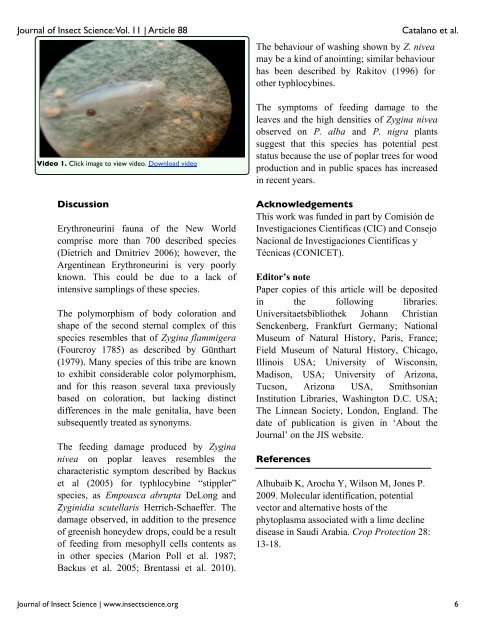Download free PDF - Journal of Insect Science
Download free PDF - Journal of Insect Science
Download free PDF - Journal of Insect Science
Create successful ePaper yourself
Turn your PDF publications into a flip-book with our unique Google optimized e-Paper software.
<strong>Journal</strong> <strong>of</strong> <strong>Insect</strong> <strong>Science</strong>: Vol. 11 | Article 88<br />
Video 1. Click image to view video. <strong>Download</strong> video<br />
Discussion<br />
Erythroneurini fauna <strong>of</strong> the New World<br />
comprise more than 700 described species<br />
(Dietrich and Dmitriev 2006); however, the<br />
Argentinean Erythroneurini is very poorly<br />
known. This could be due to a lack <strong>of</strong><br />
intensive samplings <strong>of</strong> these species.<br />
The polymorphism <strong>of</strong> body coloration and<br />
shape <strong>of</strong> the second sternal complex <strong>of</strong> this<br />
species resembles that <strong>of</strong> Zygina flammigera<br />
(Fourcroy 1785) as described by Günthart<br />
(1979). Many species <strong>of</strong> this tribe are known<br />
to exhibit considerable color polymorphism,<br />
and for this reason several taxa previously<br />
based on coloration, but lacking distinct<br />
differences in the male genitalia, have been<br />
subsequently treated as synonyms.<br />
The feeding damage produced by Zygina<br />
nivea on poplar leaves resembles the<br />
characteristic symptom described by Backus<br />
et al (2005) for typhlocybine “stippler”<br />
species, as Empoasca abrupta DeLong and<br />
Zyginidia scutellaris Herrich-Schaeffer. The<br />
damage observed, in addition to the presence<br />
<strong>of</strong> greenish honeydew drops, could be a result<br />
<strong>of</strong> feeding from mesophyll cells contents as<br />
in other species (Marion Poll et al. 1987;<br />
Backus et al. 2005; Brentassi et al. 2010).<br />
Catalano et al.<br />
The behaviour <strong>of</strong> washing shown by Z. nivea<br />
may be a kind <strong>of</strong> anointing; similar behaviour<br />
has been described by Rakitov (1996) for<br />
other typhlocybines.<br />
The symptoms <strong>of</strong> feeding damage to the<br />
leaves and the high densities <strong>of</strong> Zygina nivea<br />
observed on P. alba and P. nigra plants<br />
suggest that this species has potential pest<br />
status because the use <strong>of</strong> poplar trees for wood<br />
production and in public spaces has increased<br />
in recent years.<br />
Acknowledgements<br />
This work was funded in part by Comisión de<br />
Investigaciones Científicas (CIC) and Consejo<br />
Nacional de Investigaciones Científicas y<br />
Técnicas (CONICET).<br />
Editor’s note<br />
Paper copies <strong>of</strong> this article will be deposited<br />
in the following libraries.<br />
Universitaetsbibliothek Johann Christian<br />
Senckenberg, Frankfurt Germany; National<br />
Museum <strong>of</strong> Natural History, Paris, France;<br />
Field Museum <strong>of</strong> Natural History, Chicago,<br />
Illinois USA; University <strong>of</strong> Wisconsin,<br />
Madison, USA; University <strong>of</strong> Arizona,<br />
Tucson, Arizona USA, Smithsonian<br />
Institution Libraries, Washington D.C. USA;<br />
The Linnean Society, London, England. The<br />
date <strong>of</strong> publication is given in ‘About the<br />
<strong>Journal</strong>’ on the JIS website.<br />
References<br />
Alhubaib K, Arocha Y, Wilson M, Jones P.<br />
2009. Molecular identification, potential<br />
vector and alternative hosts <strong>of</strong> the<br />
phytoplasma associated with a lime decline<br />
disease in Saudi Arabia. Crop Protection 28:<br />
13-18.<br />
<strong>Journal</strong> <strong>of</strong> <strong>Insect</strong> <strong>Science</strong> | www.insectscience.org 6
















